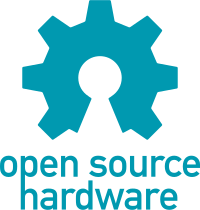

Open-source hardware (OSH, OSHW) consists of physical artifacts of technology designed and offered by the open-design movement. Both free and open-source software (FOSS) and open-source hardware are created by this open-source culture movement and apply a like concept to a variety of components. It is sometimes, thus, referred to as FOSH (free and open-source hardware). The term usually means that information about the hardware is easily discerned so that others can make it – coupling it closely to the maker movement.[1] Hardware design (i.e. mechanical drawings, schematics, bills of material, PCB layout data, HDL source code[2] and integrated circuit layout data), in addition to the software that drives the hardware, are all released under free/libre terms. The original sharer gains feedback and potentially improvements on the design from the FOSH community. There is now significant evidence that such sharing can drive a high return on investment for the scientific community.[3]
It is not enough to merely use an open-source license; an open source product or project will follow open source principles, such as modular design and community collaboration.[4][5][6]
Since the rise of reconfigurable programmable logic devices, sharing of logic designs has been a form of open-source hardware. Instead of the schematics, hardware description language (HDL) code is shared. HDL descriptions are commonly used to set up system-on-a-chip systems either in field-programmable gate arrays (FPGA) or directly in application-specific integrated circuit (ASIC) designs. HDL modules, when distributed, are called semiconductor intellectual property cores, also known as IP cores.
Open-source hardware also helps alleviate the issue of proprietary device drivers for the free and open-source software community, however, it is not a pre-requisite for it, and should not be confused with the concept of open documentation for proprietary hardware, which is already sufficient for writing FLOSS device drivers and complete operating systems.[7][8] The difference between the two concepts is that OSH includes both the instructions on how to replicate the hardware itself as well as the information on communication protocols that the software (usually in the form of device drivers) must use in order to communicate with the hardware (often called register documentation, or open documentation for hardware[7]), whereas open-source-friendly proprietary hardware would only include the latter without including the former.
- ^ Alicia Gibb (Ed.) Building Open Source Hardware: DIY Manufacturing for Hackers and Makers, Addison-Wesley: New York, pp. 253–277 (2015).
- ^ "Free Hardware and Free Hardware Designs". Free Software Foundation Inc.
- ^ Joshua M. Pearce. (2015-06-20). "Return on Investment for Open Source Hardware Development". Science and Public Policy. 43 (2): 192–195. doi:10.1093/scipol/scv034.
- ^ Gavras, Kosmas (April 2019). "OPEN SOURCE BEYOND SOFTWARE: RE-INVENT OPEN DESIGN ON THE COMMON'S GROUND". Journal of Peer Production. 13.
- ^ MacCormack, Alan; Rusnak, John; Baldwin, Carliss Y. (2011). "Exploring the Duality between Product and Organizational Architectures: A Test of the Mirroring Hypothesis". SSRN 1104745.
- ^ Gavras, Kosmas; Kostakis, Vasilis (2021). "Mapping the types of modularity in open-source hardware". Design Science. 7. doi:10.1017/dsj.2021.11. ISSN 2053-4701.
- ^ a b Theo de Raadt (2016-12-03). Open Documentation for Hardware. OpenCON 2006, 2–3 December 2006. Courtyard Venice Airport, Venice/Tessera, Italy.
- ^ Murenin, Constantine A. (2006-12-10). "Почему так важно иметь документацию по программированию железа". Linux.org.ru (in Russian).